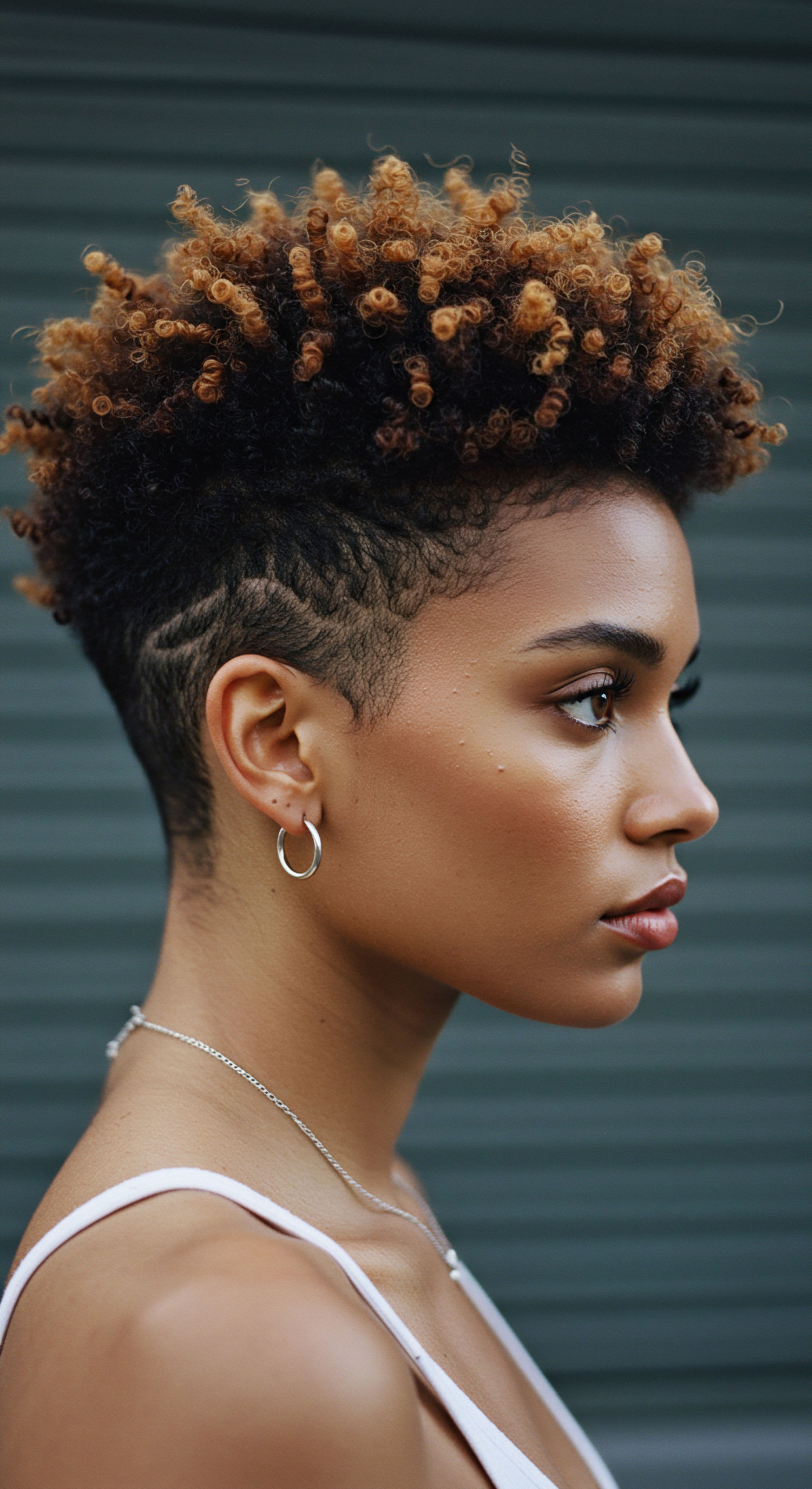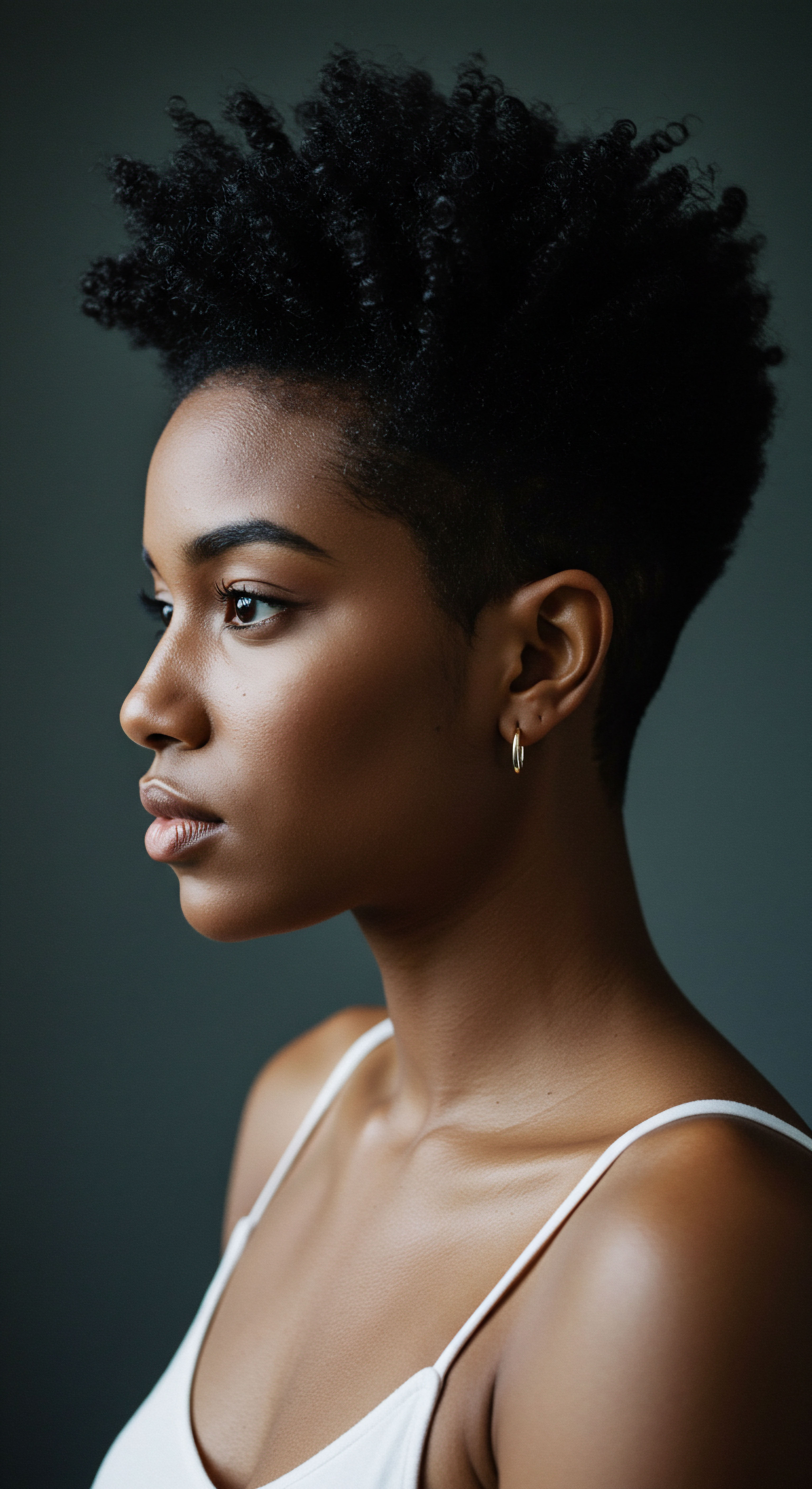
Roots
A quiet hum often surrounds our textured strands, an unseen energetic dialogue between hair and its surroundings. For those with coils, curls, and waves, this dialogue can sometimes manifest as a playful dance of flyaways, a surprising spark, or the frustrating embrace of a stray garment. This phenomenon, often dismissed as mere frizz, speaks to a deeper interplay of electrical charges, a subtle electrostatic imbalance.
Unraveling this invisible current reveals how profoundly cultural hair care practices, passed down through generations, intuitively tend to these energetic needs, often without the scientific lexicon we now possess. These time-honored rituals, born from a deep understanding of the hair’s inherent nature and its environment, offer a gentle yet powerful testament to an enduring wisdom.
Consider the very structure of textured hair, a marvel of biological engineering. Each strand, a complex protein fiber, carries a natural charge. When hair loses moisture, particularly in dry air, it becomes more prone to shedding electrons, acquiring a positive charge. Surfaces like synthetic fabrics, brushes, or even dry hands can then strip these electrons, leaving the hair strands repelling one another, creating that familiar halo of static.
The challenge for textured hair lies in its often more porous nature and its numerous bends and curves, which offer more surface area for friction and moisture loss. Traditional care, therefore, often centered on practices that either minimize this electron transfer or replenish the hair’s inherent moisture, creating a harmonious balance.

The Hair’s Energetic Surface
The outermost layer of each hair strand, the cuticle, resembles overlapping shingles on a roof. When these shingles lie flat, the hair feels smooth and appears shiny. A smooth cuticle reduces friction and helps to seal in moisture, which in turn mitigates the buildup of static electricity.
Conversely, when the cuticle is raised or damaged, hair becomes rougher, more susceptible to friction, and more likely to develop an electrostatic charge. Many traditional practices, consciously or unconsciously, aimed to smooth this delicate outer layer, creating a protective sheath that shielded the hair from external aggressors and maintained its internal equilibrium.
The natural oils produced by the scalp, known as sebum, also play a vital role in this energetic dance. Sebum provides a natural coating, acting as a lubricant and a moisture barrier. For many textured hair types, sebum does not travel easily down the spiral of the hair shaft, leaving the ends often drier and more vulnerable to static. Cultural practices frequently addressed this by incorporating external oils and butters, mimicking and augmenting the scalp’s natural offerings, thereby enhancing the hair’s protective layer and reducing the propensity for charge separation.

The Humectant Qualities of Ancient Ingredients
Across diverse cultures, ingredients rich in humectant properties—substances that draw and hold moisture from the air—were regularly applied to hair. Aloe vera, honey, various plant gels, and even certain clays possess these qualities. By infusing the hair with moisture, these natural components intrinsically reduced its tendency to become electrically charged.
Hydrated hair is less likely to lose electrons, thereby diminishing the repulsive forces that cause strands to stand on end. This intuitive understanding of moisture as a static countermeasure forms a fundamental principle within many ancestral hair care traditions.
Traditional hair care practices often intuitively balanced hair’s electrical properties by preserving moisture and reducing friction.
Consider the preparation of many traditional hair treatments ❉ the slow steeping of herbs, the meticulous grinding of seeds, the careful blending of oils. These processes often aimed to extract the very essence of the plant, concentrating its beneficial compounds. The resulting concoctions were not merely cosmetic; they were deeply nourishing balms designed to interact with the hair at a fundamental level, addressing its energetic needs with a gentle touch.
- Cuticle Integrity ❉ Practices that maintain a smooth, flat cuticle reduce surface friction and static buildup.
- Moisture Retention ❉ Hydrated hair is less prone to losing electrons and generating static charges.
- Natural Lubrication ❉ Application of oils and butters mimics sebum, creating a protective, static-reducing barrier.

Ritual
Stepping from the foundational understanding of hair’s energetic composition, we arrive at the realm of daily and periodic practices, the rituals that breathe life into hair care. These are the gentle applications, the deliberate movements, and the mindful choices that, over time, sculpt the hair’s character and subtly manage its electrostatic balance. Far from mere aesthetic pursuits, these routines are often profound acts of care, deeply connected to well-being and identity. They demonstrate a quiet mastery over the elements that affect hair’s delicate charge.
The very act of cleansing, for instance, held significant importance. While modern shampoos can strip hair of its natural oils, leaving it vulnerable to static, many cultural traditions leaned on gentler alternatives. Clay washes, herbal rinses, or co-washing with conditioning agents preserved the hair’s inherent moisture.
This approach ensured that the hair’s natural electrical balance remained undisturbed, avoiding the “squeaky clean” sensation that often precedes a static surge. By not over-cleansing, these practices prevented the hair from becoming overly dry and, consequently, highly receptive to positive charges.

The Gentle Hand of Cleansing
In many communities, harsh detergents were bypassed in favor of ingredients that cleansed without stripping. Rhassoul clay, for example, used for centuries in North Africa, absorbs impurities without depleting the hair’s vital oils. Similarly, traditional African black soap, while cleansing, often contains emollients that counteract its drying effects.
These choices reflect an intuitive understanding that hair, particularly textured hair, thrives when its natural protective layers are respected and maintained, not aggressively removed. This preservation of the hair’s lipid barrier directly contributes to reducing electrostatic charge by keeping the hair adequately moisturized.
Gentle cleansing methods from cultural traditions prevent hair from losing essential moisture, which is key to controlling static.

Nourishing the Hair’s Core
The generous application of natural oils and butters stands as a hallmark of many cultural hair care traditions. From shea butter in West Africa to coconut oil in Southeast Asia, these emollients served a purpose far beyond simple conditioning. They created a physical barrier on the hair shaft, effectively reducing friction between strands and external surfaces.
This reduced friction means fewer electrons are exchanged, thereby minimizing static buildup. The lipid content of these natural products also helped to seal the cuticle, locking in moisture and further dampening the hair’s tendency to become charged.
Consider the careful preparation of these natural balms ❉ often warmed, sometimes infused with herbs, and applied with a gentle, massaging motion. This deliberate application ensured even distribution, coating each strand with a protective layer. This ritualistic approach transformed a simple act into a deeply nourishing experience, where the very act of touch further distributed the conditioning agents and minimized aggressive handling that could generate static.

The Art of Drying and Detangling
How hair is dried and detangled profoundly impacts its electrostatic state. Air drying, often preferred in traditional settings, prevents the rapid moisture loss and excessive heat exposure that can exacerbate static. When hair is gently patted or squeezed with soft fabrics, rather than vigorously rubbed with abrasive towels, the friction is significantly reduced.
This minimizes the generation of static charges. Similarly, detangling with fingers or wide-tooth combs, starting from the ends and working upwards, reduces tension and breakage, preserving the cuticle and preventing the frictional buildup of static.
The choice of tools also plays a subtle but significant role. Wooden combs, frequently seen in various cultures, are less likely to generate static than plastic ones, as wood is a poorer conductor of electricity. This thoughtful selection of implements further illustrates the inherent understanding of hair’s energetic properties within these traditional practices.
- Oil Application ❉ Regular use of natural oils and butters creates a protective barrier, reducing friction and static.
- Air Drying ❉ Avoiding harsh heat and vigorous towel drying minimizes moisture loss and static generation.
- Gentle Detangling ❉ Using fingers or wide-tooth combs reduces friction and preserves hair’s integrity.

Relay
Moving beyond the readily apparent, we approach the intricate interplay where scientific principles subtly align with cultural practices, revealing a deeper, more nuanced understanding of electrostatic balance in textured hair. How do these time-honored methods, often devoid of modern scientific explanation in their inception, so effectively manage the very forces we now measure in coulombs and volts? The answer lies in a convergence of biological realities, material choices, and a profound respect for the hair’s intrinsic needs, all woven into the fabric of daily life.
Textured hair, with its unique helical structure, presents a particular challenge for electrostatic management. The many twists and turns mean that individual strands are more likely to rub against each other and against external surfaces. This increased surface area and inherent friction can lead to a greater exchange of electrons, resulting in a higher propensity for static buildup. Cultural practices, however, intuitively countered this by favoring styles and treatments that minimized manipulation and maximized lubrication.

The Biomechanics of Electrostatic Charge in Textured Hair
The very morphology of textured hair influences its electrostatic behavior. The elliptical cross-section and varying degrees of curl mean that the cuticle scales, even when healthy, are not always perfectly aligned. This can create microscopic points of friction. When hair is dry, and humidity is low, the hair’s electrical resistance increases, making it easier for charges to accumulate.
Conversely, water molecules are excellent conductors, allowing charges to dissipate. Therefore, practices that introduce and seal moisture are paramount. A study published in the Journal of Cosmetic Science by Robbins and Crawford (1991) explored the effect of humidity on the mechanical properties of hair, indicating that higher humidity levels reduce the stiffness and increase the flexibility of hair fibers, making them less prone to static buildup. This scientific observation aligns perfectly with the cultural emphasis on moisturizing.
Furthermore, the pH of hair products plays a silent yet significant role. Hair naturally has a slightly acidic pH, typically between 4.5 and 5.5. Products with a higher, more alkaline pH can cause the cuticle scales to lift, making the hair more porous and susceptible to static.
Many traditional rinses, such as those made with apple cider vinegar or fermented rice water, are naturally acidic, helping to flatten the cuticle and seal the hair shaft. This subtle adjustment of the hair’s surface chemistry effectively reduces friction and minimizes electrostatic charge.

The Materiality of Tradition
The tools and materials chosen in traditional hair care are not accidental; they are a testament to generations of observation and refinement. Consider the widespread use of wooden combs. Unlike plastic combs, which are insulators and can easily generate static through friction, wood is a relatively poor conductor of electricity and tends to dissipate charge more effectively. The smooth, polished surface of a well-maintained wooden comb also glides through hair with less resistance, reducing the mechanical friction that leads to static.
Similarly, the use of natural fabrics for hair wraps and bonnets, such as silk or satin, reflects an acute awareness of material science. These materials possess a smooth surface that creates minimal friction against hair strands, especially during sleep. Cotton, while natural, has a rougher surface that can create friction, leading to frizz and static. The preference for silk or satin in many cultural nighttime routines directly addresses the need to preserve hair’s moisture and prevent electrostatic charge buildup during hours of movement.
| Material Plastic Comb |
| Surface Texture Smooth to slightly rough |
| Electrical Conductivity Insulator (low) |
| Impact on Hair Static High static generation via friction |
| Material Wooden Comb |
| Surface Texture Smooth, porous |
| Electrical Conductivity Poor conductor (moderate) |
| Impact on Hair Static Low static generation, dissipates charge |
| Material Cotton Fabric |
| Surface Texture Rough, absorbent |
| Electrical Conductivity Moderate conductor |
| Impact on Hair Static High friction, can cause static and dryness |
| Material Silk/Satin Fabric |
| Surface Texture Very smooth |
| Electrical Conductivity Low conductor |
| Impact on Hair Static Low friction, minimizes static and preserves moisture |
| Material Material choice significantly influences the hair's electrostatic environment. |

Cultural Narratives of Hair and Energy
Beyond the tangible, many cultural narratives ascribe a spiritual or energetic significance to hair. In various African traditions, hair is seen as a conduit to the divine, a symbol of strength, wisdom, and connection to ancestors. This elevated status naturally led to practices that prioritized its health and vitality.
The careful handling, the use of sacred oils, and the communal grooming rituals were not merely about appearance; they were acts of reverence that inherently reduced damage and maintained the hair’s energetic integrity. This reverence for hair, often viewed as an extension of one’s vital force, naturally translated into practices that preserved its delicate balance, including its electrical properties.
The profound cultural reverence for hair often translated into meticulous care practices that inherently managed its electrostatic state.
The holistic view of well-being, where physical health is intertwined with spiritual and communal harmony, further reinforces these practices. A calm, well-tended head of hair could be seen as a reflection of inner peace and balance. The absence of flyaways or frizz, while perhaps not explicitly linked to “electrostatic imbalance” in ancient texts, was understood as a sign of healthy, well-nourished hair, a state achieved through consistent, thoughtful care that coincidentally mitigated static.
- PH Balance ❉ Acidic rinses flatten cuticles, reducing friction and static.
- Tool Selection ❉ Wooden combs and silk/satin fabrics minimize charge generation.
- Holistic Reverence ❉ Cultural value of hair encourages gentle, protective practices.

Reflection
As we gently close this exploration, a quiet appreciation settles upon the profound wisdom held within cultural hair care practices. These traditions, born from centuries of observation and deep connection to the natural world, offer more than just aesthetic solutions. They whisper secrets about balance, about harmony with our own being and the elements around us. The subtle dance of electrostatic charge on our strands becomes a lens through which we can perceive the elegant ingenuity of our ancestors, whose hands, without the aid of modern science, understood the delicate energetic needs of hair.
This journey invites us to consider how much we can still learn from the quiet wisdom of tradition, how ancient knowledge can inform our modern approaches to well-being, and how the simplest acts of care can hold the deepest truths about our hair’s vitality. The heritage of textured hair care stands as a living testament to resilience, beauty, and an enduring understanding of what it means to truly nourish.

References
- Robbins, C. R. & Crawford, R. (1991). The effect of humidity on the mechanical properties of human hair. Journal of Cosmetic Science, 42(4), 185-197.
- Hunter, L. (2011). The Science of Black Hair ❉ A Comprehensive Guide to Textured Hair Care. Self-published.
- Draelos, Z. D. (2017). Hair Cosmetics ❉ An Overview. In Cosmetic Dermatology ❉ Products and Procedures (pp. 185-195). Wiley-Blackwell.
- Bouillon, C. & Wilkinson, J. B. (2005). The Science of Hair Care. CRC Press.
- Marsh, J. M. (2007). Practical Modern Hair Science. Allured Business Media.
- Patel, V. K. & Gupta, P. K. (2012). Hair and Hair Diseases. Jaypee Brothers Medical Publishers.
- Swift, J. A. (2008). Hair Structure and Function. In Hair Growth and Disorders (pp. 1-18). Springer.
- Franbourg, A. Hallegot, P. Baltenneck, F. Freyssinet, J. M. & Bouillon, C. (2003). Current research on ethnic hair. Journal of the American Academy of Dermatology, 48(6), S115-S119.